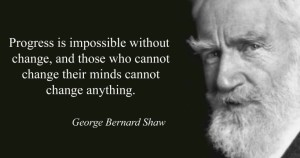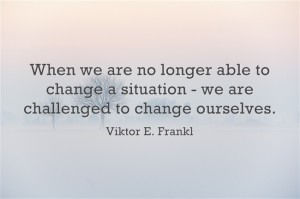Change Management with NLP and The Kotter Model
 Methods for creating and coping with changes in our personal lives and in organisations.
Methods for creating and coping with changes in our personal lives and in organisations.
.
This article compares a NLP (Neuro-Linguistic Programming) change management approach with The Kotter Change Model and outlines how these two approaches can be combined in order to compliment each other.
.
In this intensified climate of change, people, businesses and organizations are forced to either become comfortable with change or to suffer the consequences of the stress that change brings. Therefore, the ability to manage and adapt to change in one’s personal life and in the workplace is no longer a luxury, but an essential means of avoiding overwhelm and maintaining resourcefulness both during the transition and thereafter. Usually major or rapid organizational change is extremely challenging because the structure, culture, and routines of organizations often reflect a persistent and hard-to-remove “imprint” of past experiences, which are resistant to the unfolding changes of the organization. NLP involves the use of effective techniques that can be used to help those who are negatively affected by change. It does so through helping people overcome those former limiting imprints and then empowers them through establishing and integrating positive motivation strategies.
John Kotter, a Professor of Leadership, Emeritus, at the Harvard Business School, created an eight-step process for managing change that is now widely used by change managers, specifically those who work in Organisational Development and Human Resources. While Kotter’s model is primarily for organisational change, I have found it to be applicable in the context of coaching individuals who are distressed or overwhelmed by change or transition. Kotter’s basic eight-step process for organisational change is outlined below. Following that, in the second set of eight steps, I describe how each step can be applied by coaches who work with individuals that are going through a transformation in their personal life and who are struggling to cope with it.
Since organizational change has an effect on all departments and employees, everyone involved must learn how to deal with the organisation’s changes. As such, it is imperative to support the people whose performance, resiliency or commitment will be challenged through the changes. This is where the application of NLP makes a big difference.
NLP is used by many change managers to help people and organisations deal with changes effectively. NLP provides change managers with the ability to identify how each person experiences the process of change internally, and equips them with a vast and versatile set of skills to help individuals and teams move through change with greater ease and fluidity.
.
 THE MACRO & the micro
THE MACRO & the micro
.
By considering individuals to be complex systems that form part of larger, even more complex systems, each of which interrelate with each other to varying degrees, what we find is that individuals can be looked at as micro organisations. The individual human organisation consists of a physical, mental, emotional, social and spiritual dimension, all of which affect each other and shape how each person thinks, feels and behaves from moment to moment. Furthermore, by looking at corporate organisations as a large complex system that is made up of human organisations, one can easily come to the analogy that each corporate employee is a microcosm within the organisational macrocosm. Changes in the macrocosm will invariably affect each microcosm. While a single microcosm might not necessarily have a significant influence on the macro scale, it stands to reason that the optimal functioning of the whole is dependent on the coherence of its parts. On this basis, a sophisticated and holistic model of change can (with reasonable adaptions) be applicable to both individuals and organisations.
.
Kotter’s 8-Step Organisational Change Model:
- Step 1 – Create a sense of urgency
.
When employees are aware of the need and urgency for change, they will be more inclined to support it and motivated to take action. This requires and open, honest and convincing dialogue about the potential threats of not implementing the change, as well as the benefits of going through the change.
. - Step 2 – Create a guiding coalition
.
Kotter encourages the establishment of a team of change leaders from different departments within the organization. Their role is to encourage other employees to support the change and cooperate with it.
. - Step 3 – Create a vision
According to this model, a vision should be created that clearly defines where the organization is heading. Precise project plans should be put in place that lead the organization in the direction it needs to go in order to achieve the vision.
. - Step 4 – Communicate the vision
.
The vision is the outcome of the change, for which support and acceptance across the entire organization is imperative, therefore dialogue about the vision is encouraged in order to clarify it, make it easy to understand and to talk about with others.
. - Step 5 – Remove obstacles
.
Kotter stresses that it is important to identify the potential barriers to change (e.g. organizational structure, employee skill sets, individual resistance to change, etc.) and to take care of these in advance. The employees who are resistant to the change should be supported through involving them in the change process.
. - Step 6 – Create short-term wins
.
Overcoming resistance to change and building positive momentum toward the vision is promoted by setting short-term and achievable achievable goals that lead toward the desired long-term outcome. By acknowledging and rewarding those employees who are closely involved in the change process, it will become clear to all that the organisation is heading in a new and improved direction.
. - Step 7 – Consolidate improvements
.
This step of the change process focusses on gaining success momentum by maintaining urgency, encouraging employee empowerment and leading change toward the vision.
. - Step 8 – Anchor the changes
.
The final step in this model is to cement the change into the corporate culture through integrating it into the heart of the organization. For this to happen, Kotter suggests that the organization’s values and standards should be congruent with the new vision, and the new roles of the employees should be brought into alignment with this. Anchoring the changes will be supported through regular evaluation and eliciting feedback from the employees about progress and challenges.
.
The NLP Coaching Model in Kotter’s 8 steps:
- Step 1 – Create a sense of urgency
.
2 types of scenarios:
a.) When the client is in a crisis – change is desired urgently, so no need to create it.
b.) When the client is dissatisfied or frustrated with something – urgency can be created through dialogues about the implications of not changing, as well as what can be expected by going through the change, i.e. how will they experience themselves once their desired outcome has been achieved?
. - Step 2 – Create a guiding coalition
.
Elicit the client’s particular concern regarding the change. Help them to understand their deeper needs. If there is resistance to the change, then identify the parts of the client’s unconscious mind that are responsible for this, as well as the positive intention of those conflicting parts (demonstrated in our Parts Integration video).
. - Step 3 – Create a vision
.
Elicit the client’s desired outcome. If coaching a client in a specific context, elicit the state that is associated with their most fulfilling outcome in that context. If the context is the client’s entire life, then elicit a core purpose or vision for their life (explained in our Authentic Self Empowerment audio).
. - Step 4 – Communicate the vision
.
Help the client to embody the state that is associated with their desired outcome, or life purpose, or vision – through encouraging them to talk about its meaning and value to them in the relevant areas of their life.
. - Step 5 – Remove obstacles
.
There can be hidden (unconscious) benefits to having the problem or resistance to change by a part of the client’s unconscious mind. These should be identified and addressed at the outset of the coaching process, however other resistances might ‘popup’ during the process. NLP’s Reframing techniques (especially Parts Integration) plus Jevon’s ASE approach are useful for this purpose.
. - Step 6 – Create short-term wins
.
Clients should be encouraged to take small steps that are inspired from the states that arise when they are in alignment with their desired outcome, or purpose, or vision. The embodiment of their outcome, purpose or vision is the goal. Succeeding at this goal is celebrated through taking the successive steps that the goal inspires. (Our ‘How to Coach the Unconscious Mind’ video teaches this process).
. - Step 7 – Consolidate improvements
.
Coach the client to stay on track and show them how to get back on track, should they lose their way or get stuck. Inform the client about the value of regularly checking ecology along the way – “Is this change good for me, as well as those that I interact with, as well as the context in which we co-exist?”
- Step 8 – Anchor the changes
.
Following up with clients for a specified period after the intervention is recommended. This can include additional coaching or training to help anchor the changes into the appropriate context of the individual’s life. Suggesting relevant resources to support the client’s changes is also useful.
At our Change Management with NLP course, participants also learn how to incorporate NLP with The Prosci ADKAR Change Management Model and the Dialogic Organisational Development approach. In all cases, NLP has tremendous value to add when it comes to dealing effectively with change, transition and transformation.
With NLP, you get to keep the change!
.
Written by Jevon Dangeli (MSc Transpersonal Psychology, Certified NLP Trainer & Coach)
